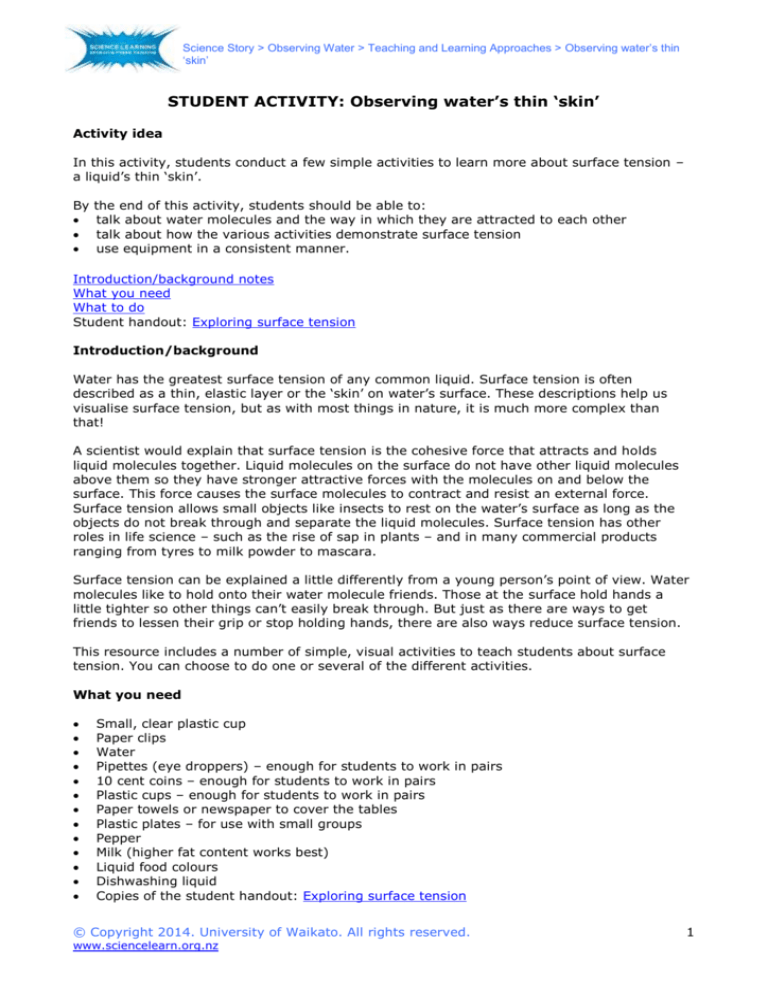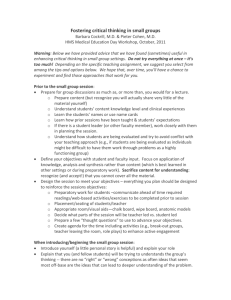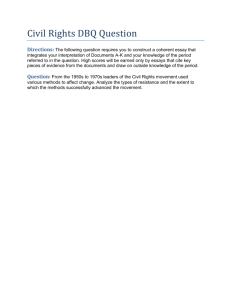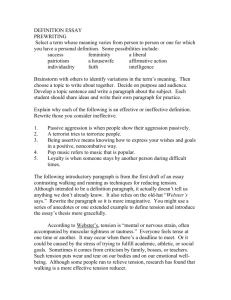
Science Story > Observing Water > Teaching and Learning Approaches > Observing water’s thin
‘skin’
STUDENT ACTIVITY: Observing water’s thin ‘skin’
Activity idea
In this activity, students conduct a few simple activities to learn more about surface tension –
a liquid’s thin ‘skin’.
By
the end of this activity, students should be able to:
talk about water molecules and the way in which they are attracted to each other
talk about how the various activities demonstrate surface tension
use equipment in a consistent manner.
Introduction/background notes
What you need
What to do
Student handout: Exploring surface tension
Introduction/background
Water has the greatest surface tension of any common liquid. Surface tension is often
described as a thin, elastic layer or the ‘skin’ on water’s surface. These descriptions help us
visualise surface tension, but as with most things in nature, it is much more complex than
that!
A scientist would explain that surface tension is the cohesive force that attracts and holds
liquid molecules together. Liquid molecules on the surface do not have other liquid molecules
above them so they have stronger attractive forces with the molecules on and below the
surface. This force causes the surface molecules to contract and resist an external force.
Surface tension allows small objects like insects to rest on the water’s surface as long as the
objects do not break through and separate the liquid molecules. Surface tension has other
roles in life science – such as the rise of sap in plants – and in many commercial products
ranging from tyres to milk powder to mascara.
Surface tension can be explained a little differently from a young person’s point of view. Water
molecules like to hold onto their water molecule friends. Those at the surface hold hands a
little tighter so other things can’t easily break through. But just as there are ways to get
friends to lessen their grip or stop holding hands, there are also ways reduce surface tension.
This resource includes a number of simple, visual activities to teach students about surface
tension. You can choose to do one or several of the different activities.
What you need
Small, clear plastic cup
Paper clips
Water
Pipettes (eye droppers) – enough for students to work in pairs
10 cent coins – enough for students to work in pairs
Plastic cups – enough for students to work in pairs
Paper towels or newspaper to cover the tables
Plastic plates – for use with small groups
Pepper
Milk (higher fat content works best)
Liquid food colours
Dishwashing liquid
Copies of the student handout: Exploring surface tension
© Copyright 2014. University of Waikato. All rights reserved.
www.sciencelearn.org.nz
1
Science Story > Observing Water > Teaching and Learning Approaches > Observing water’s thin
‘skin’
What to do
Demonstrating surface tension
1. Introduce surface tension by doing a demonstration activity. Fill a small, clear plastic cup
with water. Gather students around the cup, ensuring they are close enough to see what is
happening but not so close so that they can bump the table holding the cup.
2. Top up the cup with water so it is full to the brim. Ask
students what will happen if you drop in a paper clip. Discuss
their ideas. Continue to add the paper clips one at a time.
Watch as the water rises above the cup to form a small
dome. Continue adding paper clips until the surface tension
breaks and water spills from the cup.
3. Explain the concept of surface tension – both from a child’s
and a scientist’s point of view. There are many applications of
surface tension in the scientific world, but for young students,
keep it simple and discuss the ability of some insects to walk
on water or the ability of tent materials to repel water (until
someone touches the tent and breaks the surface tension,
allowing water to enter the finely woven fabric).
Student investigation
4. Hand out copies of the student handout Exploring surface tension and have students
investigate surface tension in pairs. First, demonstrate how to hold a pipette to ensure
uniform drops. Hold the pipette vertically and squeeze gently. Release a line of water drops
to demonstrate their uniformity. Then create a second line of water drops by holding the
pipette at a 45° or 90° angle. Discuss any differences. Explain that scientists require
accurate data so they need to use their equipment accurately and consistently. Ask
students to practise holding the pipettes vertically and squeezing water drops onto paper
towels until they have consistently sized drops.
5. Pass out the 10 cent pieces and ask students to count how
many drops they can slowly place on the coin, building up a
dome of water. One student uses the pipette while the other
counts. Record the number then reverse the roles. Students
can repeat the experiment to see if they get the same
numbers the second time around. Compare the numbers with
those around them. Discuss why there might be differences
(handling of the pipette, how fast or how high the drops are
released).
6. Finish the activity by discussing how it demonstrates surface tension. Discuss whether
children have seen similar beads of water, for example, on waxy plant leaves or on
impervious surfaces like kitchen benches or car bonnets.
Reducing surface tension – part 1
7. Soaps and detergents reduce surface tension. This is one of the reasons why soap is so
much more effective in removing dirt and grease than plain water alone. Pour water onto a
plate. Allow it to settle then sprinkle a layer of black pepper over the water. The pepper is
light so it does not break through the surface tension and sink. Add a drop of dishwashing
liquid to the middle of the plate. The dishwashing liquid reduces the surface tension. The
tension or cohesive forces between the other water molecules ‘pull’ the pepper away from
the soap.
© Copyright 2014. University of Waikato. All rights reserved.
www.sciencelearn.org.nz
2
Science Story > Observing Water > Teaching and Learning Approaches > Observing water’s thin
‘skin’
Reducing surface tension – part 2
8. Pour milk onto a plate. Use the pipettes to add a few drops of
food colouring.
9. Add a drop of dishwashing liquid to the middle of the plate.
Watch as the soap reduces the surface tension. Again, the
cohesive forces between the liquid molecules cause
movement and the colours begin to swirl. (Remind students
to be patient and watch what happens in the milk. Younger
students are often tempted to stir the milk themselves.)
Once the movement has stopped, add a drop of detergent in
another part of the milk to begin the swirls once again.
© Copyright 2014. University of Waikato. All rights reserved.
www.sciencelearn.org.nz
3
Science Story > Observing Water > Teaching and Learning Approaches > Observing water’s thin ‘skin’
Student handout: Exploring surface tension
Surface tension and
water drops
Water has strong surface tension.
Water molecules hold on tight to each other.
They form a dome on the coin.
Too many drops cause the surface tension to
break.
How many water drops can you fit onto the coin?
First try
__________
Second try
__________
Third try
__________
© Copyright 2014. University of Waikato. All rights reserved.
www.sciencelearn.org.nz
Surface tension and
soap
Soap breaks surface tension.
The molecules pull away from each other.
The soap also breaks up the fat in milk.
Draw a picture of the milk and food colours
before you add the soap.
Draw a picture of the milk and food colours after
you add the soap.
1






